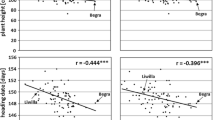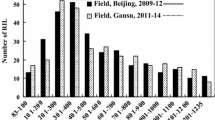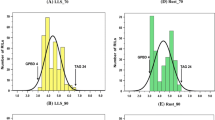Abstract
Stagonospora nodorum is the causal agent of the Stagonospora glume blotch disease in hexaploid wheat. The Swiss winter bread wheat cv. 'Arina' has a highly effective, durable and quantitative glume blotch resistance. We studied 240 single seed descent (SSD)-derived lines of an 'Arina × Forno' F5:7 population to identify and map quantitative trait loci (QTLs) for glume blotch resistance under natural infestation. Using composite interval mapping (CIM) and LOD>4.5, we detected two chromosomal regions on chromosome arms 3BS and 4BL which were specifically associated with glume blotch resistance. These identified QTLs were designated QSng.sfr-3BS and QSng.sfr-4BL, respectively. QSng.sfr-3BS peaked at the locus Xgwm389 in the telomeric region of the short arm of chromosome 3B and explained 31.2% of the observed phenotypic variance for the resistance within the population. The responsible QSng.sfr-3BS allele originated from the resistant parent 'Arina'. The QTL QSng.sfr-4BL (19.1%) mapped to chromosome arm 4BL ('Forno' allele) very close to two known genes, TaMlo and a catalase (Cat). Both QTL alleles combined could enhance the resistance level by about 50%. Additionally, they showed significant epistatic effects (4.4%). We found PCR-based microsatellite markers closely linked to QSng.sfr-3BS (gwm389) and QSng.sfr-4BL (gwm251) which make marker-assisted selection (MAS) for Stagonospora glume blotch resistance feasible. We also found one resistance QTL, QSng.sfr-5BL, on the long arm of chromosome 5B which overlapped with QTLs for plant height as well as heading time.


Similar content being viewed by others
References
Anderson JA, Stack RW, Liu S, Waldron BL, Fjeld AD, Coyne C, Moreno-Sevilla B, Fetch JM, Song QJ, Cregan PB, Frohberg RC (2001) DNA markers for Fusarium head blight resistance QTLs in two wheat populations. Theor Appl Genet 102:1164–1168
Auriau P, Rapilly F, Cauderon Y (1988) Monosomic analysis of resistance to Septoria nodorum Berk. in soft red wheat [Triticum aestivum L. em Thell (Vill) M.K.]. Agronomie 8:71–77
Bathgate JA, Loughman R (2001) Ascospores are a source of inoculum of Phaeosphaeria nodorum, P. avenaria f. sp. avenaria and Mycosphaerella graminicola in Western Australia. Aust Plant Pathol 30:317–322
Beavis WD (1998) QTL analyses: power, precision, and accuracy. In: Paterson AH (ed) Molecular dissection of complex traits. CRC Press, Boca Raton, New York, pp 145–162
Bostwick DE, Ohm HW, Shaner G (1993) Inheritance of Septoria glume blotch resistance in wheat. Crop Sci 33:439–443
Broennimann A (1968) Untersuchungen über Septoria nodorum Berk. des Weizens. Mitteil Schweiz Landw 16:65–76
Broennimann A (1975) Contributions to genetics of tolerance towards Septoria nodorum Berk. in wheat (Triticum aestivum L.). J Plant Breed 75:138–160
Broennimann A, Fossati A, Hani F (1973) Spreading of Septoria nodorum Berk. and damage to artificially induced mutants of winter wheat cultivar Zenith (Triticum aestivum L.). J Plant Breed 70:230–245
Campbell CL, Madden LV (1990) Introduction to plant disease epidemiology. John Wiley and Sons, New York, USA
Cunfer BM, Johnson JW (1999) Soft red winter wheat with resistance to Stagonospora nodorum and other foliar pathogens. In: van Ginkel M, McNab A, Krupinsky JM (eds) Septoria and Stagonospora diseases of cereals: a compilation of global research. CIMMYT, Mexico, D.F., pp 159
Cunfer BM, Ueng PP (1999) Taxonomy and identification of Septoria and Stagonospora species on small-grain cereals. Annu Rev Phytopathol 37:267–284
Duczek LJ, Sutherland KA, Reed SL, Bailey KL, Lanford GP (1999) Survival of leaf spot pathogens on crop residues of wheat and barley in Saskatchewan. Can J Plant Pathol 21:165–173
Elliott C, Zhou FS, Spielmeyer W, Panstruga R, Schulze-Lefert P (2002) Functional conservation of wheat and rice Mlo orthologs in defense modulation to the powdery mildew fungus. Mol Plant-Microbe Interact 15:1069–1077
Fried PM, Meister E (1987) Inheritance of leaf and head resistance of winter wheat to Septoria nodorum in a diallel cross. Phytopathology 77:1371–1375
Gale MD, Atkinson MD, Chinoy CN, Harcourt RL, Jia J, Li QY, Devos KM (1995) Genetic maps of hexaploid wheat. Proc 8th Int Wheat Genetics Symposium, China Agricultural Scientech Press, Beijing, China, pp 29–40
Halama P (2002) Mating relationships between isolates of Phaeosphaeria nodorum, (anamorph Stagonospora nodorum) from geographical locations. Eur J Plant Pathol 108:593–596
Haldane JBS (1919) The combination of linkage values, and the calculation of distances between loci of linked factors. J Genet 8:299–309
Hallauer AR, Miranda Fo JB (1981) Quantitative genetics in maize breeding. The Iowa University Press, Ames, Iowa, USA
Hu XY, Bostwick D, Sharma H, Ohm H, Shaner G (1996) Chromosome and chromosomal arm locations of genes for resistance to Septoria glume blotch in wheat cultivar Cotipora. Euphytica 91:251–257
Jeger MJ, Viljanen-Rollinson SLH (2001) The use of the area under the disease progress curve (AUDPC) to assess quantitative disease resistance in crop cultivars. Theor Appl Genet 102:32–40
Keller SM, McDermott JM, Pettway RE, Wolfe MS, McDonald BA (1997a) Gene flow and sexual reproduction in the wheat glume blotch pathogen Phaeosphaeria nodorum (Anamorph Stagonospora nodorum). Phytopathology 87:353–358
Keller SM, Wolfe MS, McDermott JM, McDonald BA (1997b) High genetic similarity among populations of Phaeosphaeria nodorum across wheat cultivars and regions in Switzerland. Phytopathology 87:1134–1139
Kleijer G, Bronnimann A, Fossati A (1977) Chromosomal location of a dominant gene for resistance at seedling stage to Septoria nodorum Berk. in wheat variety Atlas66. J Plant Breed 78:170–173
Lander ES, Green P, Abrahamson J, Barlow A, Daley MJ, Lincoln SE, Newburg L (1987) MAPMAKER: an interactive computer package for constructing primary genetic linkage maps of experimental and natural populations. Genomics 1:174–181
Laubscher FX, von Wechmar B, von Schalkwyk D (1966) Heritable resistance of wheat varieties to glume blotch (Septoria nodorum Berk.). Phytopathology Z 56:260–264
Loughman R, Wilson RE, Goss IM, Foster DT, Murphy NEA (1999) Varieties and advanced lines resistant to Septoria diseases of wheat in Western Australia. In: van Ginkel M, McNab A, Krupinsky JM (eds) Septoria and Stagonospora diseases of cereals: a compilation of global research. CIMMYT, Mexico, D.F., pp 145–148
Ma H, Hughes GR (1993) Resistance to Septoria nodorum blotch in several Triticum species. Euphytica 70:151–157
Ma H, Hughes GR (1995) Genetic control and chromosomal location of Triticum timopheevii-derived resistance to Septoria nodorum blotch in durum wheat. Genome 38:332–338
Ma ZP, Steffenson BJ, Prom LK, Lapitan NLV (2000) Mapping of quantitative trait loci for Fusarium head blight resistance in barley. Phytopathology 90:1079–1088
McDonald BA, Linde C (2002) Pathogen population genetics, evolutionary potential, and durable resistance. Annu Rev Phytopathol 40:349–379
McIntosh RA, Hart GE, Devos KM, Gale MD, Rogers WJ (1998) Catalogue of gene symbols for wheat. Proc 9th Int Wheat Genetics Symposium, Saskatoon, Saskatchewan, University Extension Press, University of Saskatchewan, vol 5
Meier U (2001) Growth stages of mono- and dicotyledonous plants. 2nd, Federal Biological Research Centre for Agriculture and Forestry (BBA), Braunschweig, Germany
Mittelstadt A, Fehrmann H (1987) The occurrence of the perfect stage of Septoria nodorum in the Federal Republic of Germany. J Plant Dis Protect 94:380–385
Mittler R (2002) Oxidative stress, antioxidants and stress tolerance. Trends Plant Sci 7:405–410
Nelson LR, Gates CE (1982) Genetics of host plant resistance of wheat to Septoria nodorum. Crop Sci 22:771–773
Nicholson P, Rezanoor HN, Worland AJ (1993) Chromosomal location of resistance to Septoria nodorum in a synthetic hexaploid wheat determined by the study of chromosomal substitution lines in Chinese Spring wheat. Plant Breed 110:177–184
Paillard S, Schnurbusch T, Abderhalden O, Messmer M, Sourdille P, Winzeler M, Keller B, Schachermayr G (2003) An integrative genetic linkage map of winter wheat (Triticum aestivum L.). Theor Appl Genet (in press)
Piffanelli P, Zhou FS, Casais C, Orme J, Jarosch B, Schaffrath U, Collins NC, Panstruga R, Schulze-Lefert P (2002) The barley MLO modulator of defense and cell death is responsive to biotic and abiotic stress stimuli. Plant Physiol 129:1076–1085
Polley RW, Thomas MR (1991) Surveys of diseases of winter wheat in England and Wales, 1976 to 1988. Ann Appl Biol 119:1–20
SAS Institute (1991) SAS language and procedures: usage 2, version 6, first edition. SAS Institute Inc, Cary, N.C., USA
Scharen AL (1966) Cyclic production of pycnidia and spores in dead wheat tissue by Septoria nodorum. Phytopathology 56:580
Scott PR, Benedikz PW, Cox CJ (1982) A genetic study of the relationship between height, time of ear emergence and resistance to Septoria nodorum in wheat. Plant Pathol 31:45–60
Shah D, Bergstrom GC (1993) Assessment of seed-borne Stagonospora nodorum in New York soft white winter wheat. Plant Dis 77:468–471
Skadsen RW, Schulze-Lefert P, Herbst JM (1995) Molecular cloning, characterization and expression analysis of two catalase isozyme genes in barley. Plant Mol Biol 29:1005–1014
Utz HF (1995) PLABSTAT—a computer program for statistical analysis of plant breeding experiments. Version 2.0M. Institute of Plant Breeding, Seed Science and Population Genetics, University of Hohenheim, Stuttgart, Germany
Utz HF, Melchinger AE (2000) PLABQTL: a computer program to map QTL. Version 1.1. Institute of Plant Breeding, Seed Science, and Population Genetics, University of Hohenheim, Stuttgart, Germany
Van der Plank JE (1963) Plant diseases: epidemics and control. Academic Press, New York, USA
Van Ginkel M, Rajaram S (1999) Breeding for resistance to the Septoria/Stagonospora blights of wheat. In: van Ginkel M, McNab A, Krupinsky JM (eds) Septoria and Stagonospora diseases of cereals: a compilation of global research. CIMMYT, Mexico, D.F., pp 117–126
Walag H, Dzieglo A (1985) Monosomic location of genes for resistance to Septoria nodorum (Berk.) in the spring wheat (Triticum aestivum L.) variety Sappo. Hodowla Roslin Aklimatyzacja I Nasiennictwo 29:11–19
Walag H, Dzieglo A (1987) Location of resistance genes to Septoria nodorum (Berk.) of summer wheat of the Weibull15440 variety (Triticum aestivum L.). Hodowla Roslin Aklimatyzacja I Nasiennictwo 31:1–6
Wicki W, Winzeler M, Schmid JE, Stamp P, Messmer M (1999) Inheritance of resistance to leaf and glume blotch caused by Septoria nodorum Berk. in winter wheat. Theor Appl Genet 99:1265–1272
Willekens H, Chamnongpol S, Davey M, Schraudner M, Langebartels C, VanMontagu M, Inze D, VanCamp W (1997) Catalase is a sink for H2O2 and is indispensable for stress defence in C-3 plants. Embo J 16:4806–4816
Zhou WC, Kolb FL, Bai GH, Shaner G, Domier LL (2002) Genetic analysis of scab resistance QTLs in wheat with microsatellite and AFLP markers. Genome 45:719–727
Zhu H, Gilchrist L, Hayes P, Kleinhofs A, Kudrna D, Liu Z, Prom L, Steffenson B, Toojinda T, Vivar H (1999) Does function follow form? Principal QTLs for Fusarium head blight (FHB) resistance are coincident with QTLs for inflorescence traits and plant height in a doubled-haploid population of barley. Theor Appl Genet 99:1221–1232
Acknowledgements
We thank B. Senger and P. Streckeisen for their excellent technical assistance, and R. Enderlin for conducting the field trials in Haag, Canton St. Gallen, Switzerland. We are grateful to Prof. Dr. H.F. Utz for providing the computer packages PLABSTAT and PLABQTL. This work was supported by the University of Zürich. The authors declare that the experiments conducted for this publication comply with the current laws of Switzerland.
Author information
Authors and Affiliations
Corresponding author
Additional information
Communicated by H. C. Becker
Rights and permissions
About this article
Cite this article
Schnurbusch, T., Paillard, S., Fossati, D. et al. Detection of QTLs for Stagonospora glume blotch resistance in Swiss winter wheat. Theor Appl Genet 107, 1226–1234 (2003). https://doi.org/10.1007/s00122-003-1372-3
Received:
Accepted:
Published:
Issue Date:
DOI: https://doi.org/10.1007/s00122-003-1372-3




